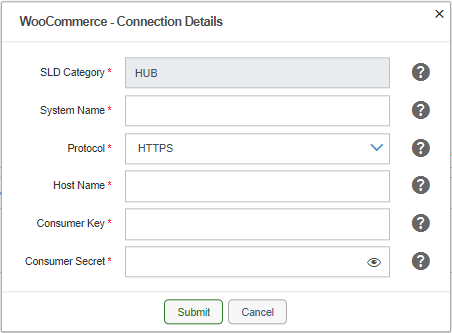Step 1 – Set Connectivity of WooCommerce and SAP Business One
- Choose the SAP Business One SLD to provide the connection between SAP Business One System Id and WooCommerce Id.
Note
By default, the solution displays all the SAP Business One SLDs available in SLD Category selected during customer creation.

- To add a new SLD or edit existing SAP Business One SLD under SAP Business System Id area, choose
Add / Edit button.
The SAP Business One Connection Details window contains the following fields:
Field Name
Description
SLD Category
Displays the SLD Category selected during customer creation. This field is read only.
System Name
SAP Business One Server
License Server
Enter License Server details. i.e. Server Name or IP Address and port number of the SAP Business One License Server.
The default port is 30000.
SLD Server
Database Name
Database Type
Database User
Database Password
Database Port
Enter the port for database.
Username
Password
Enter a valid password for B1i user of SAP Business One.
Language
Select the language from the list of languages.
Is Trust
Select True or False. The default value for this field is False. To use a trusted connection, choose True from the dropdown list.
JcoPath
Enter path for jco library. Example of Installation path of JCO: C:\Program Files (x86)\SAP\SAP Business One DI API\JCO\LIB
DI ProxyHost
DI ProxyPort
The default value of DI Proxy Port is 2099.
Proxy Host
The proxy host is defined in a multi-instance scenario. If the B1i server connects to the SAP Business One server through a proxy server then, enter the address of the proxy server in this field.
Proxy Port
Enter the proxy port in this field.
- Enter the valid data and choose the Submit button. An SAP Business One SLD is created.
- Choose the Test Connection
icon to test the connection between the SAP Business One System Id in Integration Hub and SAP Business One System Landscape Directory.
If the connection is successful, a success message appears “Test Connection Successful”. If the connection is unsuccessful, a failure message appears “Test Connection Failed”. Please provide the correct credentials.
- To add / edit WooCommerce instance SLD under WooCommerce Id area, choose the
Add / Edit button.

The WooCommerce Connection Details window contains the following fields:
Field Name
Description
SLD Category
Displays the SLD Category selected during customer creation. This field is read only.
System Name
Protocol
Select Protocol from HTTP / HTTPS.
Host Name
Hostname of WooCommerce site. The hostname is fully qualified domain name. For Example if you access WooCommerce site using URL: https://myhubstore.wpcomstaging.com/wp-admin/ , then the hostname of the WooCommerce site is : myhubstore.wpcomstaging.com
Consumer KeyConsumer Secret
Enter the Consumer Secret Key generated by WooCommerce.
- Provide the valid information in the fields and choose the Submit button. SLD for WooCommerce will be created.

- Choose the Test Connection
icon to test the connection between the Integration Hub and WooCommerce.
If the connection is successful, a success message appears “Test Connection Successful”.
If the connection is unsuccessful, a failure message appears “Test Connection Failed”.
- Choose the Next button to proceed to Step2.
Next step: Step 2- Scenario Selection of WooCommerce in the Integration Hub
Related Articles
Step 2 – Scenario Selection of WooCommerce in the Integration Hub
The Scenario Selection summary displays the Scenario Name, Data Direction, and Field Mapping. The Field Mapping further displays information of the Field in SAP Business One and the mapped field in WooCommerce. Configuration Summary 2. The ...Step 3 - Deployment of WooComerce in SAP Business One Integration Hub
To deploy the solution, choose the Deploy Now button. The application prompts you to provide the license details. For more information, refer to the Assigning the Integration Hub licenses Knowledge Article. The Integration Hub displays the Deployment ...Initialization Process of WooCommerce in Integration Hub
Once the WooCommerce feature is enabled in SAP Business One, it is mandatory to initialize the objects to be integrated between SAP Business One and WooCommerce. The objects include Products, Inventory, Customer. Note Ensure that the Weight Unit and ...WooCommerce integration with SAP Business One
WooCommerce is an open-source e-commerce plugin for WordPress. It is designed for small to large-sized online merchants using WordPress. The integration between WooCommerce and SAP Business One facilitates automated, bi-directional data exchange ...General Settings of WooCommerce in the Integration Hub
Configure the general settings in the General Settings tab in the WooCommerce Settings window. The General Settings tab of the WooCommerce Settings window contains the following fields: Field Name Description Default Price List used for Items Prices ...